We're a makerspace in Sydney: a communal space where geeks and artists brainstorm ideas, play games, work on collaborative projects, and share the cost of some great tools.
Don't wanna be here? Send us removal request.
Text
2025
Welcome to 2025!
If you are looking to renew your membership for the new year, head on over to our membership platform.
If you have any questions you can ask on the mailing list.
We hope to see you in Meadowbank soon!
0 notes
Text
Creating a GPS Treasure Box
Andrew did a write up of one of his projects that we would love to share. We wish you all a happy ❤️Valentines Day!❤️
---
Many years ago I came across the idea for a GPS treasure box, from a post originally by Kenton Harris (I think - apologies if it was somebody else). Some called it a reverse geocache too, but in simple terms, it's a locked box that only opens at a certain location.
The idea behind the box was a very simple interaction - one button, and a screen. The process would go like this:
Press button
Screen lights up, and GPS begins scanning
Screen tells you how many attempts you have left
Once GPS has location, the distance from the target location in kilometers is shown
One attempt is removed from total # of attempts
Screen turns off
Eventually, the target location would be found (and the box unlocks), or the attempts will run out and the box will be sealed shut forever!
Inspired to create a fun adventure for myself and a friend on a weekend in Spain, I ordered all the relevant components including GPS module, Arduino Uno, batteries and a servo motor to lock the box. This was back in January of 2020.
Ah, how times change...
---
Fast forward to January of 2023. I'd moved back to Sydney years prior and still had all of these components sitting around. I knew I'd get to this project one day.
I came across a local makerspace with access to a laser cutter. This was the missing ingredient I needed - not only were there the facilities I needed to create the treasure box, there was also vibrant community of people who had done similar things before.
I started out by gathering some code to power the project, and thankfully found a number of helpful repositories on Github.
I was able to clone one, and adapt it to the paricular hardware and display I was using pretty easily. Annoyingly I had to learn all about Baud rates and GPS modules - but I'm glad I did as I'm sure it will contribute to projects in the future.
---
At long last, the finished project was here.
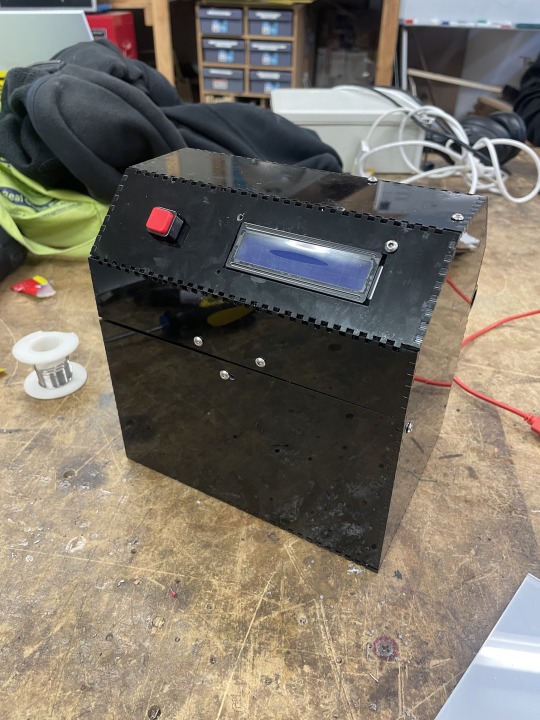
Not too shabby I thought, but it was time to put it to the test.
I enlisted the help of my girlfriend. We began at home and she pressed the button.
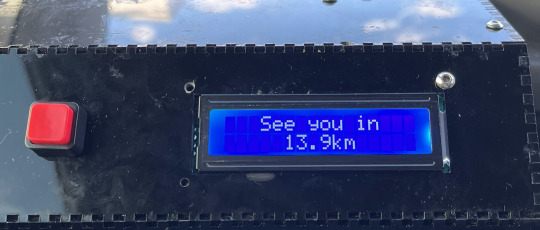
As a guess, she told me to head to Pyrmont, an inner-city suburb. So off we drove.
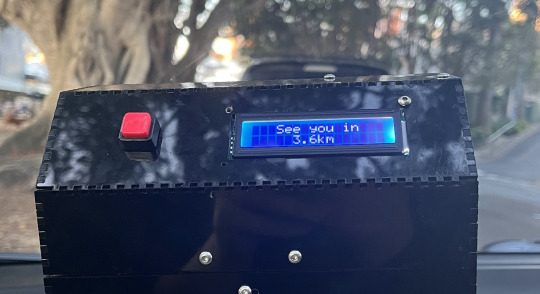
Getting warmer! And still with heaps of attempts left.

With the sun setting, we headed to a nice spot in Rose Bay, by the water.
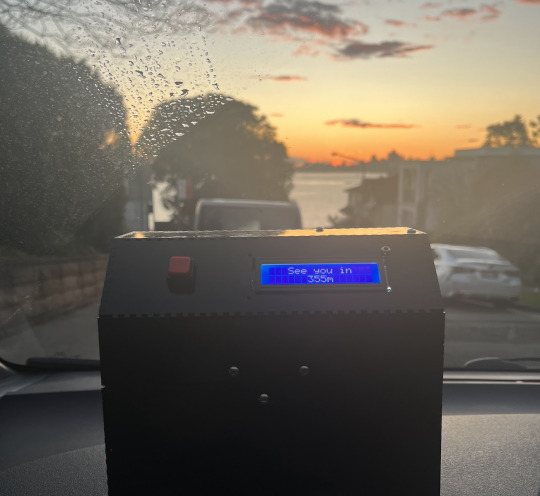
It was close enough to continue on foot, so we decided to put the dog in a backpack (I didn't realise prior that he was not allowed in Sydney Harbour National Park, so I hope this was an OK compromise! Apologies to the national parks service).
---
Here, my true colours were revealed. I'd actually added some extra code into the mix - getting the box to ask a very important question on my behalf.

And sure enough, the box opened on cue, revealing an exciting treasure hidden within!
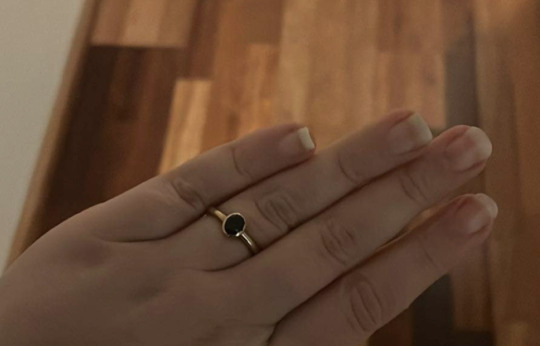
4 notes
·
View notes
Text
Yes, we are still alive! We just suck at writing stuff.
So, like all groups, we are terrible about updating our website.
Let this be a record that despite us not updating the website, we have been going strong the last 7 years , being open every Tuesday and Saturday (lockdown excepted) and having the space filled with creative people making stuff & having fun.
Hopefully we'll update more frequently over the next 7 years, but in the unlikely event we don't, please come say hello anyway.
Here's one of our recent projects for ref. A glowing DnD dice tray.

3 notes
·
View notes
Text
Fairies Don’t Poop
So if you’re after a weekend project, and you need to placate tiny humans, you could do a lot worse than a Fairy Cottage.
A fairy cottage is like a dolls house except you don’t play with it, you put it somewhere and invite fairies to come and live in it by being quiet and going to sleep.
I’ve taken the concept and made into a night light using an Arduino and a set of addressable LEDs.
it’s powered by a USB wallwort and each room will randomly light between 5 and ten minutes. Theoretically it might not light at all, but statistically it should turn on at least one room after a while.
Here it is:

read on for build instructions
OK, so the cottage itself is from here
http://www.makecnc.com/berea-contrast-house.php
and is really well designed and detailed. The zip file has versions for lasercut and CNC and for different thicknesses of material: 5 out of 5, would download again.
The only thing i would say is that if you’re using cheap wood (and i would) its not going to hold up to much abuse. The roof is supposed to lift off but its a pain to get on and off and i broke a bit just trying to get it to sit straight. YMMV
Anyway, you’ll want to take the DXF laser file of your choice and then split it into 600x400 pages so you can cut it on the laser cutter.
you’ll end up with this

that’s 5 sheets of wood, but i think you could get it down to 4 if you were a bit better than me with your placement. If you use the cheap bunnings ply that’s $20.
A note about the roof, i used 60mm/s at 15% for the tile pattern but because the roof has a lot of repeated lines it cut too deep and warped the roof. Even though it’s sooooo much slower, you might be better off using engrave.
ok, start making, you need to glue the windows, everything else is locking hook tabs.

i’ve drilled a hole for the usb cable to poke through.

it’s really hard to assemble. i’d start with the inner walls, then the inner floor, then the outer walls, but at some point you have to force one end.

The windows are glued together, i filled a teaspoon with PVA and then dipped my finger in and touched the wood as required.
The ‘glass’ is grease proof paper which worked great.

I had a bit of APA102 addressable LED strip left over from another project. I threaded it through each room.

Some pillow stuffing material is used for chimney ‘smoke’.
I did try lighting the smoke but by the time the led was bright enough to light the smoke it also lit up the chimney so it looked weird.

Fairy Cottage or Portal to Hell, the LED brightness is important.

With everything constructed i left the last roof panel off while i worked on the code.
The Code
So you’ll find the code here, and it’s also a great place for any questions you may have (it’s the Robodino mailing list)
https://groups.google.com/forum/#!topic/sydney-hackspace/gS0tefDlLKI
I use the polou led library
https://github.com/pololu/apa102-arduino
these strips are like the ws2812 except they are faster and (imo) easier to use. they do require one more pin than the ws2812.
I played around with both the high level and low level library interface, in the end i found the right brightness and used the high level which is simpler, and each room has a different colour light.
here’s the flow:
power up: all lights off; create a random seed based off an unattached analog pin
1. wait between 3 and 5 minutes
2. randomly pick a room
3. either turn the light on or off in that room (if the light is already off, it can still choose to turn it off; in which case no change is perceived).
4. goto 1
There are two exceptions, The toilet turns on for 30 seconds only, then turns off. ...Because faeries don’t poop.
In a future version i might program one of the LEDs to act like a tv, throwing out random colours around 15fps but i need a bit of time to work on that.
Other thoughts:
you could make this into a proper dolls house by having the roof hinge and run the wiring in the wall cavity. Laser cut holes in the walls for the led to shine through.
you could use a servo with a fairy silhouette stuck to the arm that would cast a shadow against the window every so often. I tried cutting out a fairy shape and hanging it in the room but it just looked like someone had hung themselves, not really what i was going for.
2 notes
·
View notes
Text
TempClock

Kris finished a project!
I needed a device that would show the temperature in the house, outside and in the kids’ room. It should also have the time. We only need it at night and we need it to be very dim. After a loooooot of prototypes this is what I made:

We had a bedside alarm clock that had internal and external temperature. But it wasn’t backlit so you couldn’t read it at night at all. Because our house is old, there is a big difference in temperature between the different rooms. Too cold and our kids wake up in the night; then so do we.
So I had a very small OLED display in my parts bin. I also had a few of the dallas temperature monitors hanging about. I figured I’d make a quick temperature display. I also had a RealTimeClock module so I figured I’d put the time on there as well.
I thought it would take me an afternoon. Four months later I finished it.
The two big problems i had were the size of the screen and the one wire protocol which was a bit iffy.
These are the temperature sensors I was using: Dallas (Maxim) DS18B20 1-wire. They say one wire but you actually need three (in theory you can use two, but I tried and couldn't get it to work): Power, Ground and Signal. There’s lots of tutorials on the web about how to use these but the main issue I had was the resistor value. I had three sensors, one in the box, one under the house and one in the kids’ room (behind a book case). Wired up using some solid core UTP cat5 I had left over. On the breadboard everything worked, but in real life the sensor at the end would not read. It would detect, but not read. Eventually this was fixed by dropping the resistor value to around 2.8k.
The other issue was the display: it’s a tiny 128x64 OLED display less than an inch across the diagonal. It came free with a digispark pro I had ordered. The display worked great but unless you were up close and personal, you couldn’t read it.
I decided that I could use a lens to ‘project’ the screen onto a larger screen. Since it was to be used at night, the dimming effect this would have would not be an issue.
Optics are HARD.
The first lens was taken from a broken projection clock. The issue was the lens was only 11mm in diameter, much smaller than the OLED, by the time it was in focus it was too close to the lens and the edges were heavily distorted.
So i went to a dollar store and got a magnifying glass. Much bigger diameter. I sawed the handle off and mounted it in a laser cut box. This didn’t work because the focus point was about 8 feet!.
Next up i got some lenses designed for google cardboard, and made a laser cut box with more boxes inside, so i could slide each element and work out the focus, then build a purpose built box.

This produced terrible results. Though at least we were down to about 110mm for focus.
Next up was the medium onto which we were projecting. We were projecting from the rear so I needed a medium that lights could hit, but also pass through, without too much diffusion.
I tried:
Sanding glass (uneven, produces nasty particles)
Engraving perspex (too opaque)
Paper (not rigid enough)
Grease proof paper (not rigid enough, but did work quite well)
Ever so slightly textured vinyl i got from a ring binder (worked well, not opaque enough but produced an interesting ‘hologram’ like effect. The problem was you could see the original screen through it and it made it hard to read)
So i had issues with both the lens and the screen. I was about to give up and buy another, larger screen when someone suggested a slide viewer. Since the slide was about the right size as the OLED module.
The finished product uses a Vistarama slide viewer form the 60′s. I got two broken ones for $18 delivered via ebay. The other one was an Argus previewer which (imho) is better looking but harder to cram all the electronics in.
Build instructions:
These are the basic steps needed to reproduce my rather hacky project. Feel free to jump on the Robodino list and ask questions.
Parts:
Arduino Pro Mini (you’ll need a serial module to program it) I used a 5v pro mini as the OLED screen was 5v
OLED module You don’t have to get a shield, anything equivalent will work that uses I2C
Three Dallas DS18B temp sensors
USB phone charger and or 5v source
a bit of strip board
A slide viewer ( i got mine on ebay but have a look around your local flea market, if you’re a robodino member you can have my spare Argus Previewer)
How to build it
Mainly just throw it together, but anyway:
drill two holes, one for the power (usb) cable and one for the remote one wire sensors.
get an usb cable you don’t want and snip the end that DOESN’T go in the computer off, strip the wires and identify the 5v and 0v line (typically red and black). poke it though the hole, stop it falling back with a zip tie and solder it to the strip board.
poke some cat 5 cable through the other hole and solder three conductors to 5v, 0v and a new strip which will be for signal.
Put a 2.7k ohm resistor on the strip board between the 5v strip and the signal strip. If you’re only using one sensor or have a short run, use a 4.7kOhm resistor.
Solder the I2C Real time clock module to the power lines on the strip board and the control lines to the arduino pins (follow this guide)
I connected the signal line of the temperature sensors to pin 2. If you do the same you won’t have to look at my code, which is a good thing.
shove it in the box. I used tape to insulate the two boards. I laser cut a little plastic window to tape the oled display to, then slid that into the slide viewing slot.
You’re done!
Code is here:
https://groups.google.com/forum/#!topic/sydney-hackspace/22qDhfwMh9Q
You’ll need to set the RTC clock first (use the example code).
You’ll need all the libraries mentioned at the top of the code.
You may want to put a button to adjust the time to account for drift and or daylight savings.
0 notes
Text
Lasercut Settlers of Catan
Hi All, Gav here!
At the space recently we’ve had a few rounds of Settlers of Catan. People seemed to like it, so I figure we should have a set living on a shelf in the workshop. Some late night lasering later, and we have this:

At the request of James, this version has recesses to hold the roads and cities in place, so that his more… enthusiastic… rolls don’t knock over the board:

All the wood is bamboo ply, lasercut. The hex tiles are lightly sanded and given an acrylic paint wash, before being given a clear gloss. The base has a Jarrah stain (Yes, I know it looks terrible where the glue wasn’t sanded off enough), and I might end up clear-coating it later.
The settlements and cities have their own little silhouettes, and I made a holder for each player’s unplaced pieces:

Files are up here if anyone wants to make their own:
http://www.thingiverse.com/thing:1343362
0 notes
Text
Stained Glass Workshop & Kiln Work
Hi All, Gav here!
You know the space is no stranger to eletronics, lasers and 3D printing, but that’s certainly not all we get up to.
Recently, I got a bunch of glass tools, and a bunch of us have been having fun making stained glass pieces, as well as doing some kiln work. Here’s a few pieces we made:

It’s a rather addictive medium to work with! There’s a huge range of colours and effects you can get. Stained glass is quick to get ideas out with, but for more intricate stuff we can use a kiln to mix and fuse pieces together.
Glass cutting during the workshop:
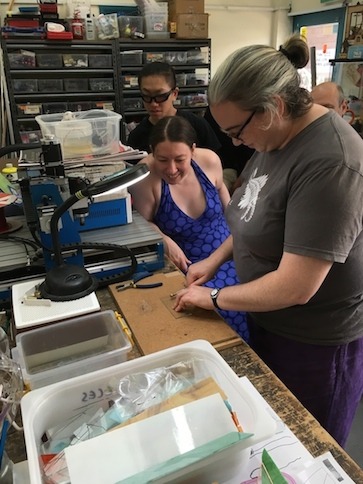
The pieces laid out and ready for copper foil to be added. The table is actually a light-box, which helps positioning translucent glass for various effects:

Also that table isn’t just a slab of egg-crate. According to the vendor, it’s a entire sophisticated glass cutting system, and it comes with a 50 page manual showing how to set up templates for various angles, reliably repeating cuts, etc. A few of us have ideas for giant hexagon themed pieces, and that’ll make doing hundreds of pieces a tad easier...
The space already has a large kiln, but for testing ideas and various glass combinations, I recently bought a microwave kiln. This allows small glass pieces to be slumped, tacked or fully fused together. Here’s a pieces ready for firing:

And some pieces we finished earlier:

Most of these are just playing with settings, rather than being a particular design. By controlling the time of firing, we can select how much the glass fuses or slumps together.
I’ve left a big selection of the specialist tools and glass stock for people to play with. If you’ve got an idea for a fused or stained glass piece, feel free to have a go!*
(Get one of us to show you how to handle & cut glass safely, of course).
There’s also a prize for the first stained glass Robots and Dinosaurs logo to be made :-)
0 notes
Text
Mardi Gras lights!
Ada, Tim and everyone who was around at the time helped out a regular who runs a Mardi Gras float. Thanks everyone for the spectacular lights!
The colours all corresponded to different words on the five maypoles, so we wanted all thirty or so different strands to be different colours.
The circuit that was designed for the purpose has been written up in an electronics magazine.
There were many near misses - the electronics ran late and we never got to light up the signage, even then we only got the float to the city two minutes before lockdown; one battery pulled out and a whole pole went dark but it was quickly fixed by judicious use of an occy strap; by the end of the parade the pole with one fewer battery gave up its fine colours and glowed only red!
Still, it was a huge undertaking and an amazing result. A fantastic time was had by all, and even though we were far from the biggest or brightest float of 2014, it’s been well remembered (and even understood!) by many people from the crowd.
Anyone wanting more info or who would like to help out on next year’s float (providing you are queer-friendly and atheist-friendly!) can visit queeratheists.org.
0 notes
Photo


This is a stand for hatpins, the deadly ornament women used to secure their hats to their heads in the nineteenth and early centuries. The long pin is very Titanic, made to fix a giant hat to bouffant hair, but the others are probably from later, as hats got smaller and hairstyles simpler. I needed a way to stop my hatpins from stabbing me, so when I got my hands on the simple 3D design program at tinkercad.com, i designed one. This is based off some silver versions from the 1920s. It got scaled smaller than I intended, so it would fit in the machine, but it still does the job!
0 notes
Photo

Today we have been making gears among other things
1 note
·
View note
Text
Ralph, the little robot who did!
RoboDino ran a robotics workshop on the weekend. It was a design from one of our members and comes in at less than $25 AUD!. It was great fun and by the end of the day we had 15 little robots chasing each other around a line. More pictures inside!!





youtube
3 notes
·
View notes
Text
Making parts for the new laser on our CNC
Recently we ran a small workshop on using the CNC. Although we really only scratched the surface (LOL) during the workshop, later that evening Max and I were talking about brackets for the new laser, and decided the CNC was the best way to make something with the precise offsets needed to keep the beam level.
I thought I'd do a quick write up, so people can see what's involved. All up it was probably just over an hour to go from idea to having both parts finished.
We designed up the part, imported it as a DXF file into CAMBAM. told it the tool diameter (3mm), the material thickness (10mm), and what speeds and feeds were acceptable (300mm/min for feed, and 200mm/min for plunging), and that it was only allowed to remove 1.1mm of surface material at a time.
The computer calculated how many passes were needed, and generated the code:

We loaded up the code in MACH3:

Clamped our workpiece down and zeroed the machine:

And started cutting:

Here's the result after 20 minutes of cutting. The edges were nice and flat:
(We did deburr the bottom surface, though)

And test-mounted on the lasercutter:

I'd forgotten how much of a joy milling acrylic can be. It behaved really nicely, and the noise wasn't even that loud (the vacuum cleaner used to clean the mess was much louder). I'm certainly going to use it again in the future.
Cheers,
Gav
1 note
·
View note
Text
New space!
The hackerspace has MOVED!
After a lot of messing about, we finally moved shop and are settling in nicely to our new address, 10/27 bank st Meadowbank! It's right across the road from Meadowbank station.
We still have of work to do settling in but so far the new space has a much cleaner, brighter and friendlier vibe, so we are all excited and thankful it is over! Below is a time lapse I made of the unpacking.
Housewarming to come soon!
1 note
·
View note
Text
In which we make a wool carding machine for an Alpaca
One of our members, Judit, had a bit of a challenge recently when she got an Alpaca fleece and needed to card it.
Wool 'carding' is the process of teasing and aligning the fibres to remove knots, and it must be done before spinning the wool. Carding machines are vey expensive, but the actual carding brushes are fairly cheap, so we designed a laser-cut set of drums and frame to make our own machine:

Two power drills provide motion. The process is not quite as gentle as you'd expect...

But the results were pretty respectable:

Next step is getting practice on our spinning wheel to make thread:

1 note
·
View note
Text
Lasercutters & Lamps
Here's a few projects that have been made in the space recently:

Here's Judit's Hippo & Fox:

Max also finished his scratch-built lasercutter recently. Here's it being used by one of our young members:

0 notes





